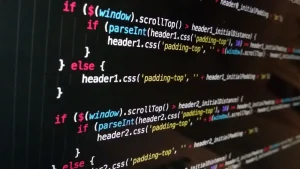Dive into the world of functional programming (FP) in JavaScript! Learn core concepts, practical applications, and best practices to write cleaner, more maintainable, and testable code.
Master Functional Programming in JavaScript: Write Cleaner, More Powerful Code
Functional programming (FP) is a programming paradigm that emphasizes functions as the building blocks of software. It’s gaining traction in JavaScript due to its ability to create cleaner, more maintainable, and testable code. In this comprehensive guide, we’ll embark on a journey to master FP in JavaScript, equipping you to write powerful and efficient applications.
Embracing Functional Programming in JavaScript
Before diving into specifics, let’s contrast the two main programming paradigms: imperative and functional. Imperative programming focuses on how to achieve a result through a sequence of instructions that modify variables. Functional programming, on the other hand, emphasizes what needs to be achieved, utilizing functions to transform data without directly modifying it.
This distinction leads to several key advantages of functional programming:
- Immutability: Data remains unchanged within functions, ensuring predictable behavior and easier debugging.
- Pure Functions: Functions produce the same output for the same input, leading to more reliable code.
- Declarative Style: Code expresses what needs to be done, not how, improving readability and maintainability.
- Composability: Functions can be easily combined due to their pure nature, leading to reusable and concise code.
- Reduced Side Effects: Functional programming minimizes reliance on external factors, making code more predictable and easier to test.
While not a silver bullet, incorporating elements of functional programming into your JavaScript toolkit can significantly enhance your code’s quality and maintainability.
Understanding Functional Programming Concepts
Now, let’s delve into the core concepts that underpin functional programming:
1. Pure Functions:
Pure functions are the cornerstone of functional programming. They meet the following criteria:
- Deterministic: They consistently produce the same output for the same input values.
- No Side Effects: They don’t modify external state (variables outside the function’s scope).
Example:
function add(x, y) {
return x + y;
}
const result1 = add(2, 3); // result1 will always be 5
const result2 = add(2, 3); // result2 will also be 52. Immutability:
Functional programming emphasizes creating new data structures, leaving existing ones untouched. This ensures predictable behavior and simplifies debugging. Libraries like Immutable.js provide tools for creating immutable data structures in JavaScript.
Example:
const originalArray = [1, 2, 3];
// Functional approach (creates a new array)
const newArray = originalArray.concat(4);
// Imperative approach (modifies the original array)
originalArray.push(4);
console.log(originalArray); // [1, 2, 3] (functional approach)
// [1, 2, 3, 4] (imperative approach)3. Higher-Order Functions:
Higher-order functions (HOFs) operate on other functions as arguments or return functions as results. They empower you to write more concise and reusable code. Common HOFs include map, filter, reduce, and forEach.
Example:
const numbers = [1, 2, 3, 4, 5];
// map
const doubledNumbers = numbers.map(number => number * 2);
console.log(doubledNumbers); // Output: [2, 4, 6, 8, 10]
// filter
const evenNumbers = numbers.filter(number => number % 2 === 0);
console.log(evenNumbers); // Output: [2, 4]
// reduce
const sum = numbers.reduce((accumulator, currentValue) => accumulator + currentValue, 0);
console.log(sum); // Output: 15
// forEach (used for side effects, not typically functional)
numbers.forEach(number => console.log(number));4. Functional Data Structures
Functional programming often utilizes specialized data structures that align with its principles. These structures are typically immutable, meaning they cannot be changed after creation.
- Lists: Represent ordered collections of elements, similar to arrays but often immutable.
- Trees: Hierarchical structures used for efficient searching and sorting.
- Maps: Key-value pairs for efficient data retrieval.
While JavaScript’s built-in arrays and objects can be used functionally, libraries like Immutable.js offer more robust and performant implementations of functional data structures.
5. Recursion
Recursion is a powerful technique in functional programming where a function calls itself to solve a problem. It’s often used for tasks like traversing data structures or implementing algorithms like factorial or Fibonacci.
Example:
function factorial(n) {
if (n === 0) {
return 1;
} else {
return n * factorial(n - 1);
}
}6. Composition
Functional programming encourages composing functions to build complex logic from simpler ones. This promotes code reusability and readability.
Example:
const add = (x, y) => x + y;
const multiply = (x, y) => x * y;
const addAndMultiply = (x, y, z) => multiply(add(x, y), z);Practical Applications of Functional Programming in JavaScript
Functional programming isn’t just about theoretical concepts; it has practical applications in modern JavaScript development:
1. Data Transformation
Functional programming excels at transforming data using higher-order functions like map, filter, and reduce.
Example:
const users = [
{ name: 'Alice', age: 30 },
{ name: 'Bob', age: 25 },
{ name: 'Charlie', age: 35 }
];
// Filtering users older than 30
const olderUsers = users.filter(user => user.age > 30);
// Extracting names of all users
const names = users.map(user => user.name);2. Asynchronous Programming
Functional programming can simplify asynchronous code with techniques like promises and async/await. Libraries like RxJS offer functional reactive programming (FRP) capabilities for handling complex asynchronous data streams.
3. User Interface Development
Functional programming principles can be applied to build reactive and declarative user interfaces. Frameworks like React embrace functional components and state management for efficient UI updates.
4. Testing
Functional programming’s emphasis on pure functions and immutability makes testing easier. Unit tests can be written with confidence, as functions are isolated and less prone to side effects.
Essential Functional Programming Libraries for JavaScript
Several libraries provide a rich set of functional programming tools for JavaScript developers:
- Ramda: A comprehensive library with a focus on point-free style and currying.
- Lodash/fp: A functional subset of Lodash, offering utility functions for data manipulation.
- Immutable.js: Provides persistent data structures for efficient and immutable state management.
- RxJS: For functional reactive programming, handling asynchronous data streams.
Adopting a Functional Programming Mindset
Shifting to a functional programming mindset takes practice. Start by incorporating small functional elements into your codebase. Gradually increase your use of functional patterns as you become more comfortable. Remember, functional programming is a tool in your arsenal, not a strict dogma.
Best Practices for Mastering Functional Programming in JavaScript
- Start Small: Begin by applying functional concepts to small code sections.
- Leverage Higher-Order Functions: Utilize
map,filter,reduce, and other HOFs effectively. - Embrace Immutability: Prioritize creating new data instead of modifying existing ones.
- Write Pure Functions: Aim for functions with no side effects and predictable outputs.
- Compose Functions: Build complex logic by combining smaller functions.
- Consider Functional Libraries: Explore libraries like Ramda or Lodash/fp for additional tools.
- Learn from Others: Study well-written functional code and learn from experienced developers.
You May Also Like:

